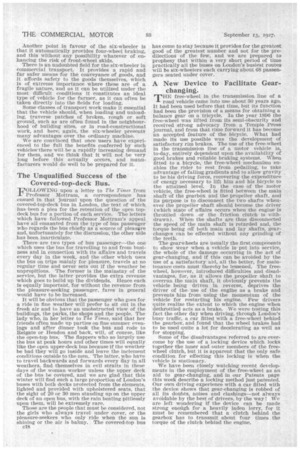A New - Device to Facilitate Gearchanging. T HE free-wheel in the
Page 40

If you've noticed an error in this article please click here to report it so we can fix it.
transmission line of a road vehicle came into use about 30 years ago. it had been used before that time, but its function had been the provision of a means for obtaining a balance gear on atricycle. In the year 1896 the free-wheel was lifted from its semi-obscurity and received strong advocacy from a Temple Press journal, and from that time forward it has become an accepted feature of the bicycle. What had made its use possible was the development of satisfactory rim brakes. The use of the free-wheel in the transmission line of a motor vehicle is, to-day, entirely dependent upon the availability of good brakes and reliable braking systems. When fitted to a bicycle, the free-wheel mechanism enables the rider to rest from pedalling, to take advantage of falling gradients and to allow gravity to be his driving force, recovering the expenditure of energy necessary to lift him and his bicycle to the attained level. In the case of the motor vehicle, the free-wheel is fitted between the main shaft of the gearbox and the propeller shaft, and its purpose is to disconnect the two shafts whenever the propeller shaft should become the driver (which state of affairs occurs when the engine is throttled down or the friction clutch • is withdrawn). When the shafts are thus disconnected the speed of the main shaft is retarded and, the torque being off both main and lay shafts, gearchanges can be effected without any grinding of the teeth. The gearwheels are usually the first components to show Wear when a vehicle is put into service, the whole of the damage occurring in the act of gear-changing, and if this can be avoided by the use of a satisfactory aid, all the better, for maintenance costs must thereby be lessened. The freewheel, however, introduced difficulties and disadvantages, for, as it allows the propeller shaft to overrun the main shaft, it obviously prevents the vehicle being driven in reverse, deprives the driver of the use of the engine as a brake and prevents him from using the momentum of the vehicle for restarting his engine. Few drivers quite realize the extent to which the engine when dethrottled acts as a brake. We were testing this fact the other day when driving, through London's busy traffic, a car fitted with a free-wheel behind the gearbox, and found that the wheel brakes had to be used quite a lot for decelerating as well as for stopping. Some of the disadvantages referred to are overcome by the use of a locking device which locks together the inner and outer members of the freewheel clutch, but it is apparent that the only safe condition for effecting this locking is when the vehicle is stationary. We have been closely watching recent developments in the employment of the free-wheel as an aid to gear-changing, and in our Patents page this week describe a locking method just patented. Our own driving experience with a ear fitted with the device shows that gear-changing is robbed of all its doubts. noises and dashings—not always avOidable by the best of drivers, by the way ! We are left wondering if the device can be made strong enough for a heavily laden lorry, for it must be remembered that a dutch behind the gearbox has to transmit about four times the torque of the clutch behind the engine.












































































































